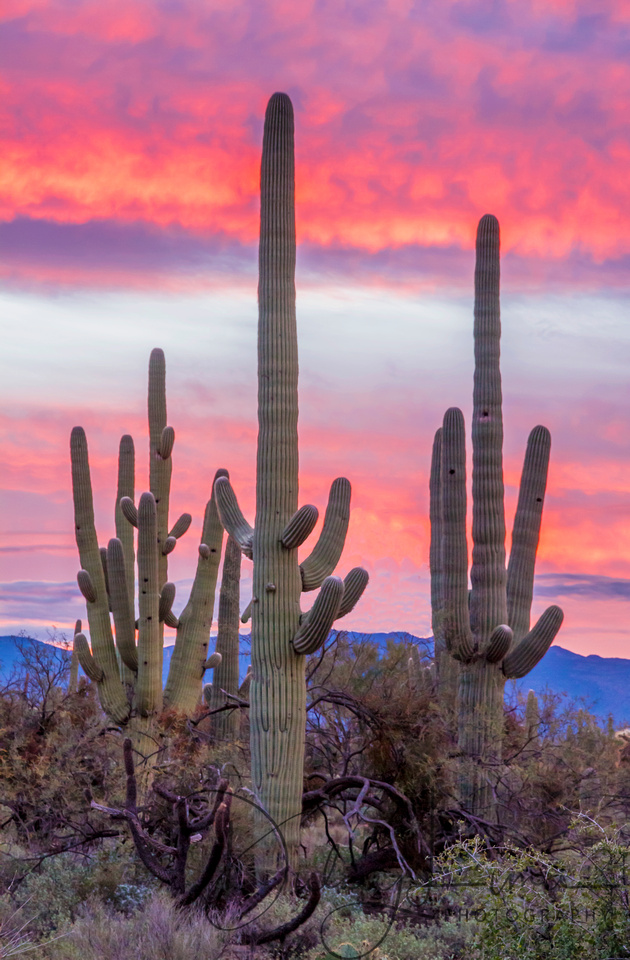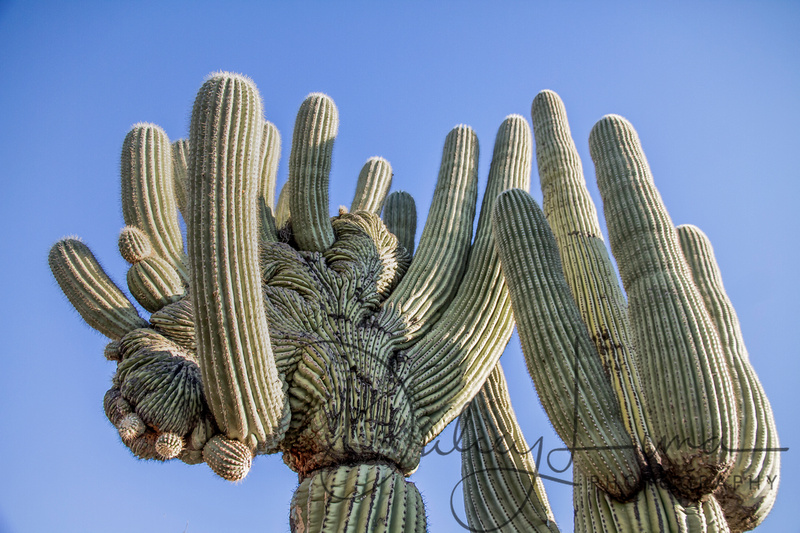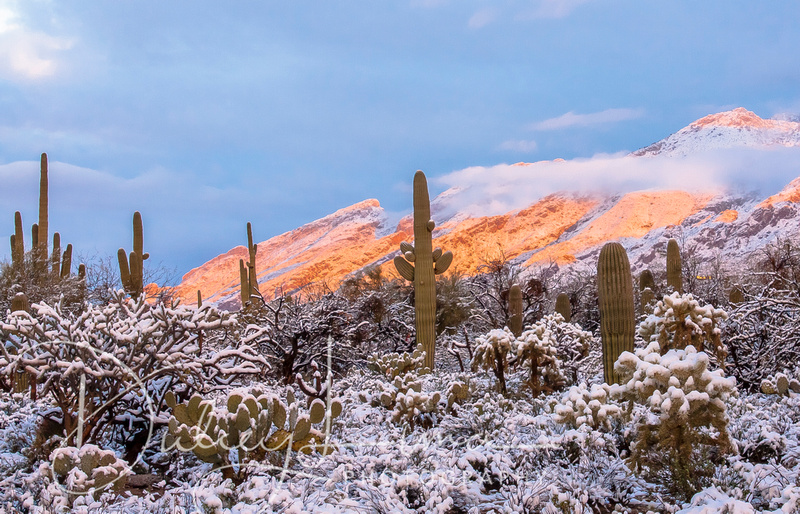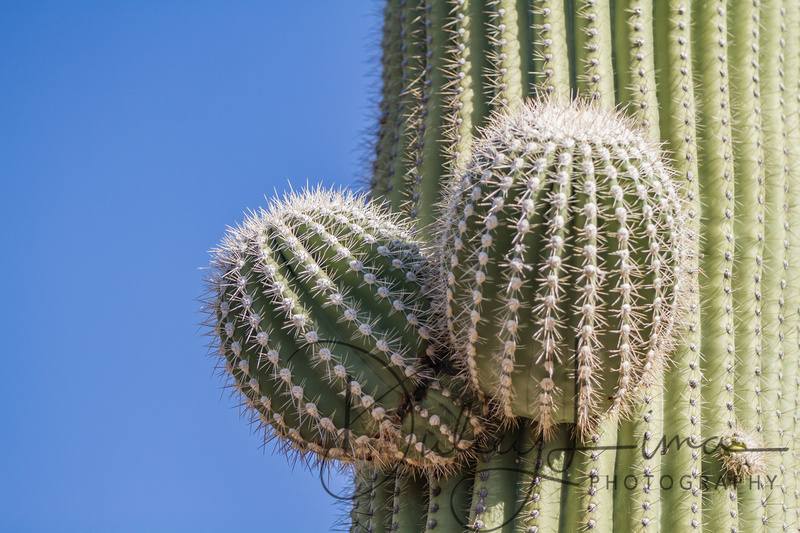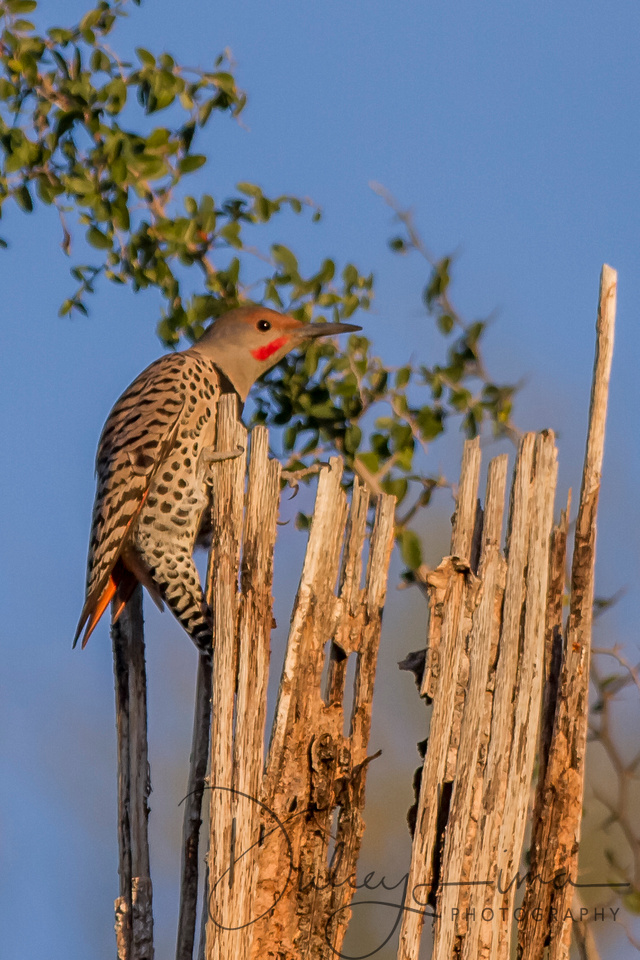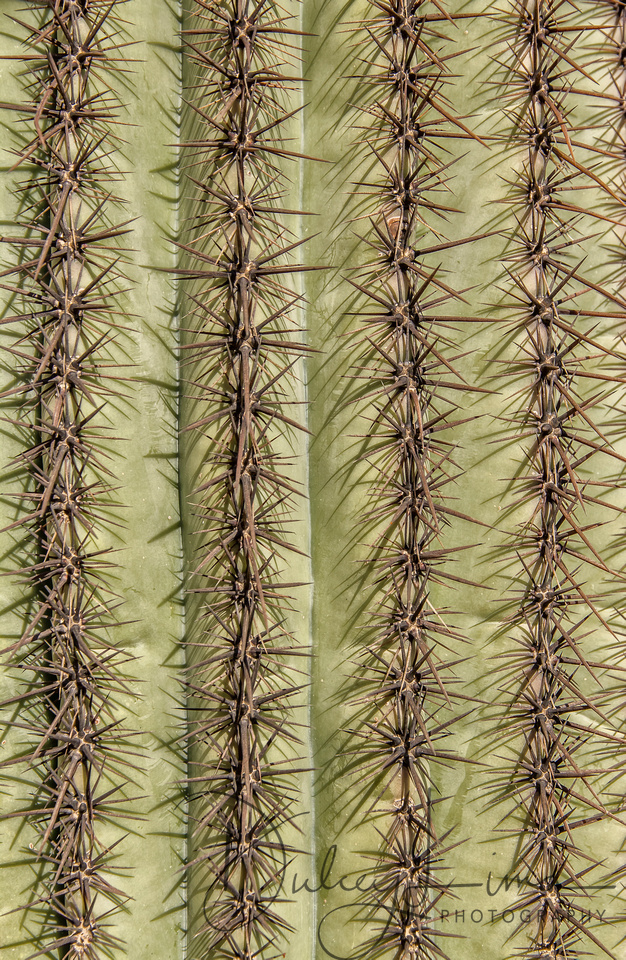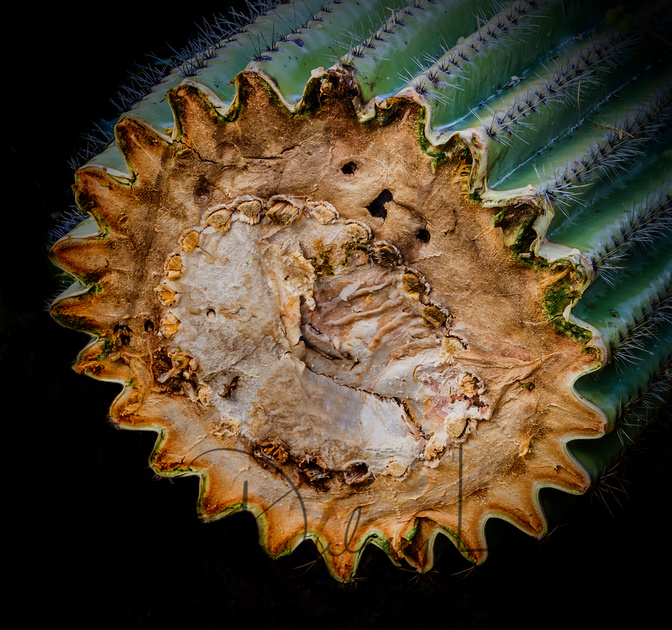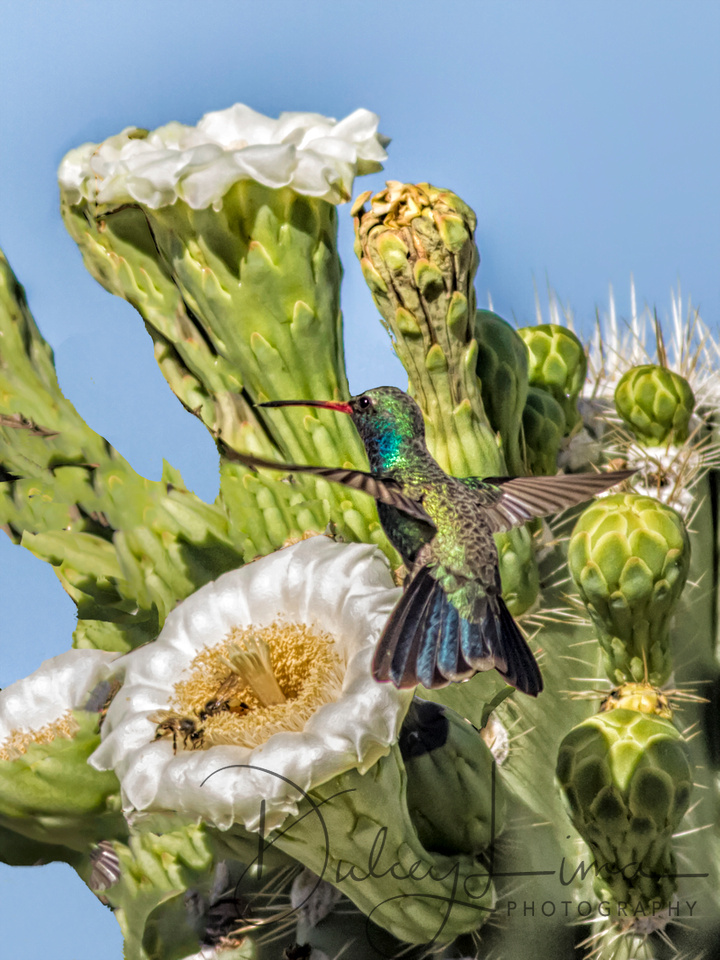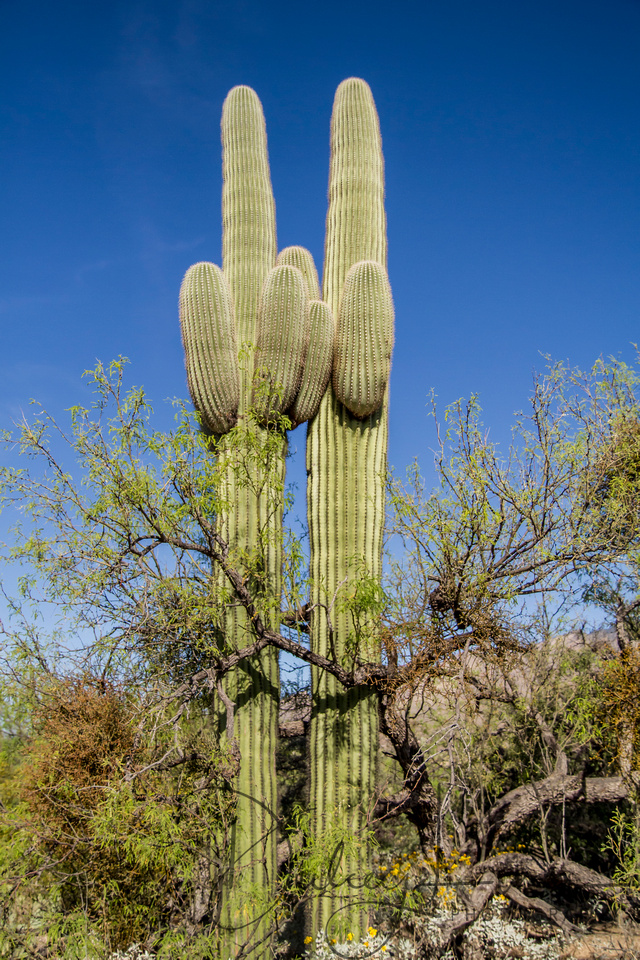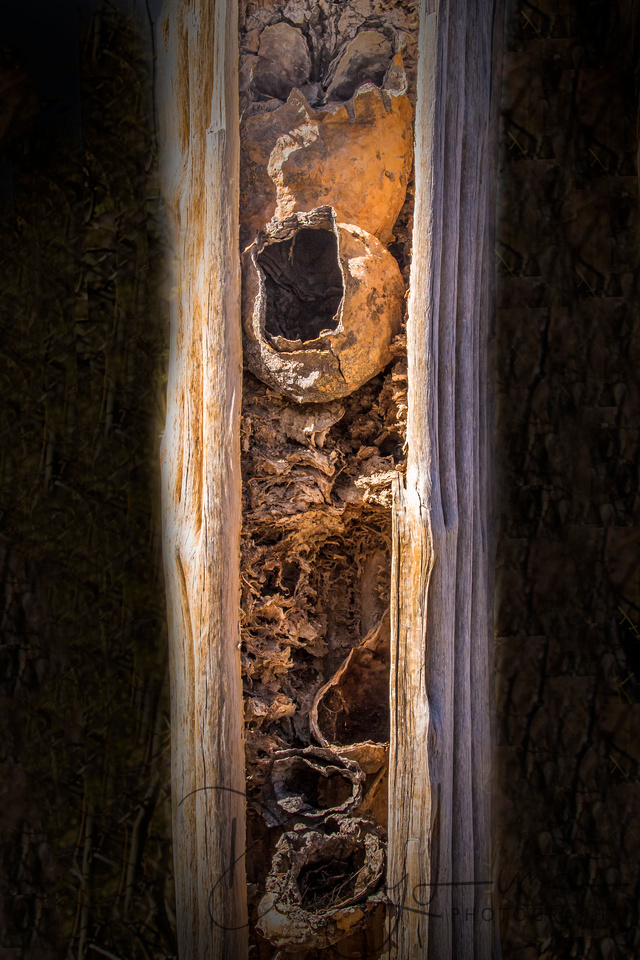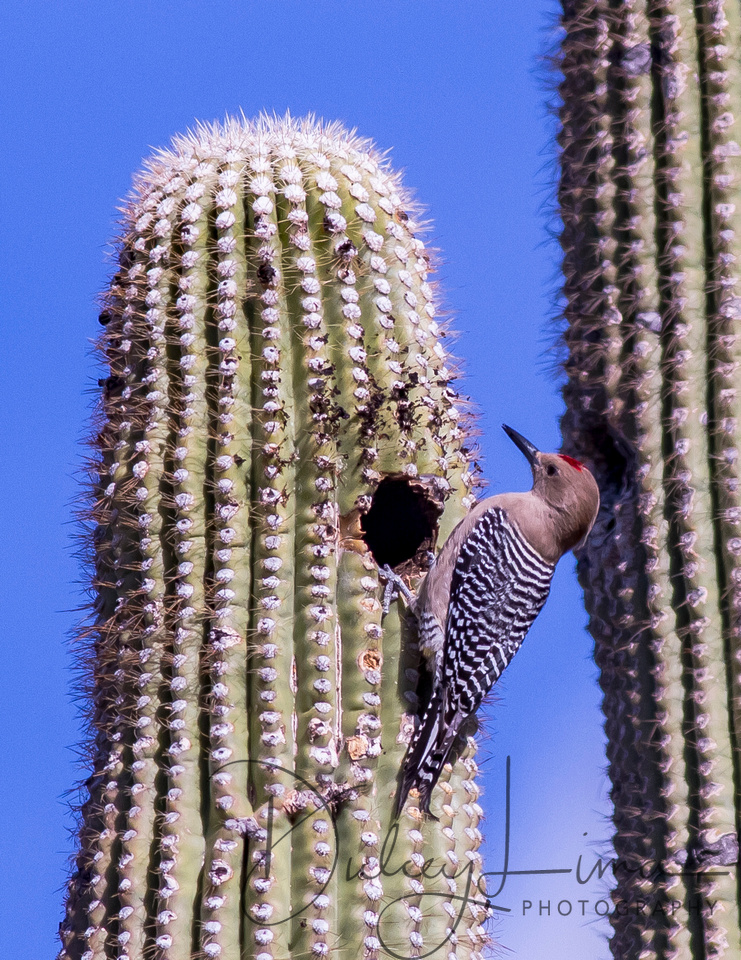Saguaros--Sentinels of the Desert
The majestic Saguaro Cactus, (Carneglea gigantean), is a living symbol of the Southwest and its bloom is the state flower of Arizona. Exceedingly slow-growing—a ten-year old plant is less than 2 inches tall! In adulthood it will tower over all the other plants of the Sonoran Desert and reach about 45 feet. All the growth occurs at the tips. By 70 years old a Saguaro can reach 6.5 feet and begin producing flowers. By 95-100 years a Saguaro Cactus can reach 15-16 feet and may start to produce its first arm. It reaches adulthood at about 125 years, and may live to be up to 200 years old. Saguaros don’t always produce arms, and when they do not, the Saguaro is called a spear. Arm buds normally emerge first at the greatest trunk or stem diameter. Since flowers are produced at the tip of each arm or stem, growing new arms increases the number of flowers and fruits, the likelihood of reproducing, and serves to ensure the survival of the species.
This thriving, dual stemmed Saguaro with a tremendous number of arms is likely 125-200 years old.
Saguaros have a waxy skin that helps to prevent water loss, gives protection against predators, and protects against sunburn and freezing temperatures. Snow does fall in the Sonoran Desert but is generally short-lived in the Saguaro habitat. Saguaros can not tolerate temperatures below 23 degrees for longer than about 29 hours before freeze damage occurs, which can harm the arms of the cactus, causing them to drop downward.
Tufts of 2" spines are distributed evenly on every pleat on the main trunk and on every arm. Since the majority of a Saguaro is made up of water, an adult cactus can weigh 4-6 tons or more. The enormous weight is supported by a circular skeleton of interconnected, woody ribs which correspond to the number of pleats on the outside of the plant. New ribs form by forking as the Saguaro grows, and the corresponding pleats follow the same pattern. The rib skeleton remains standing long after the cactus has died.
A Gilded Flicker perches on the ribs of a dead Saguaro cactus. Along each vertical rib on the waxy exterior are 2” straight (not hooked) tufted spines with a felt like material in the center that provides shade and protection from freezing temperatures. The spines are also a barrier from hungry animals like mule deer, jack rabbits or big horned sheep who will resort to eating the fleshy Saguaro exterior in times of drought or limited food supply.
Beginning at the outside edge, the parts of the cactus are the spines, epidermis (green, waxy layer), cortex or pulp, ribs, and pitch (inside the ribs). The Saguaro has one main tap root that can extend 2-5 feet underground to provide stability and absorb water from underground sources. In addition, it has a network of hairy roots that extend out from the base of the cactus as far as the Saguaro is tall. These roots specialize in water absorption and are only 3-5” below the ground. They take advantage of any rain that falls in the desert, even when there is fast runoff due to water and snow melt over the highly compacted desert soil. The superficial roots also wrap around rocks to provide stability, which is important, given the height, weight, and mountainous conditions in which the Saguaro grows. These roots can absorb up to 200 gallons of water during a rainfall, and help to withstand winds and overly saturated soil that can topple a water-laden Saguaro. Saguaro flowers bloom at night during May and June and stay open until the following midday but not all of the creamy white, three inch flowers with yellow centers bloom at once. Each cactus averages about 4 open flowers a day for about 30 days. The primary night pollinator is the long-nosed bat who is attracted by the sweet scent of nectar and is perfectly suited given the high position of the substantial flowers that can withstand the bat’s weight. Daytime pollinators include honey bees, white winged doves, a variety of hummingbirds, orioles, woodpeckers, gilded flickers, verdins and house finches. As soon as the blossom is pollinated, it starts to set fruit.
Ladder-Backed Woodpecker
Broad-billed Hummingbird If the fruit of the Saguaro is eaten by a coyote or cactus wren, the seeds pass through their digestive tract unharmed and are distributed throughout the desert in scat. But if the seeds are eaten by a dove or quail, they will be completely absorbed in their digestive system. Few seeds will survive to become a seedling, and fewer still will become an adult Saguaro. The low survival rate is attributed to drought, prolonged freezing, animals eating or stomping on the young seedlings and loss of nurse plant habitat. The three inch oval, green fruit ripens and splits open to reveal the red, pulpy flesh, appreciated by all desert animals. The Pima, Tohono O'odham and Papago Indians dried, fermented, canned and stored the fruits and used the seeds for flour and porridges. Saguaro seedlings benefit from growing under “nurse trees” which are usually Mesquite, Palo Verde or Ironwood varieties. The trees provide shade and protection from predators and freezing temperatures. The branches of these trees also provide stability to the young Saguaros whose root system is not well developed, and often the cactus will be wrapped gently within a branch of the tree. The Saguaro generally outlives the nurse tree, given that most Saguaros survive 1-2 centuries.
A Mesquite "nurse" tree shields two nearly identical Saguaros at Sabino Canyon. Saguaros are characterized as foundation species because they support so many other species in the ecosystem. Despite their sharp spines, Saguaros serve as “hotels” for birds like Gila woodpeckers, which carve out nest holes in the plants. The Saguaro “heals” the holes by creating a solid, internal casing around the cavity, which also provides a perfect nest inside the cactus. Called cactus “boots”, these internal structures were also used by Native Americans as containers for water and food.
An opening in the woody skeleton of a dead Saguaro reveals a number of "cactus boots" which developed after woodpeckers excavated nesting holes. Since flickers and Gila woodpeckers create new holes every year, other birds like elf owls, house finches, fly catchers and purple martins move in to the pre-owned nest. Red tailed hawks and other large birds nest in the intersections between the main stems and arms. These holes do not appear to be problematic for the Saguaro given its ability to wall off external holes created by birds or insects. Freezing temperatures, lightening or overwhelming mechanical damage are the biggest threats to a Saguaro’s survival once it has become established. Even Saguaros struck by lightning or “decapitated” by the wind or other force can sometimes continue to grow new arms, bloom and survive.
A Gila Woodpecker peaks out of his Saguaro home. The Saguaro’s strong architectural form, ability to survive climate extremes, remarkable variances in shape and proximity to beautiful mountain ranges and desert have earned it a special niche in the American Southwest. It is a symbol and sentinel of the Sonoran Desert, a plant to emulate for its adaptability and strength, and a reminder that even under the harshest conditions, the desert is an interconnected network of animals, plants and other organisms that thrive in their unique location on planet earth.
For more information about Saguaro Cactus, check out these webpages that I used to gather the information for this blog.
https://www.nps.gov/sagu/learn/nature/saguaro_roots.htm https://www.nps.gov/sagu/learn/nature/how-saguaros-grow.htm https://www.sciencefriday.com/articles/11-things-you-didnt-know-about-saguaro-cacti/ https://www.fs.fed.us/wildflowers/plant-of-the-week/carnegiea_gigantea.shtml https://www.desertmuseum.org/kids/oz/long-fact-sheets/Saguaro%20Cactus.php https://www.desertusa.com/cactus/saguaro-cactus.html https://en.wikipedia.org/wiki/Saguaro https://www.nps.gov/sagu/learn/nature/why_pleated.htm https://www.nps.gov/tont/learn/nature/saguar https://www.nps.gov/sagu/learn/nature/saguaro_reproduction.htm https://www.fs.fed.us/database/feis/plants/cactus/cargig/all.html http://npshistory.com/series/science/17/saguaro-ecology-3.pdf
Keywords:
Boot,
Cactus,
Canyon,
Cristate,
Desert,
flicker,
hummingbird,
Mountains,
National,
Park,
Ribs,
Sabino,
Saguaro,
Skeleton,
Sonoran,
Tucson,
woodpecker
Comments
It’s a surprisingly harsh AAS on cholesterol for many people, which is a good purpose to limit its use. Virilization is an actual risk for ladies utilizing Turinabol, so female dosages have to be saved low sufficient to avoid these unwanted effects. Nevertheless, most ladies will need to begin lower at about half that amount (2.5mg). Perhaps the only most noticeable impact of Tbol is the power increase it supplies.
The price of Dbol can range relying on the supply and the dosage, but it sometimes ranges from $50 to $100 for a cycle. Anavar contributes to power enhancement as nicely, but with a focus on endurance enchancment, aiding athletes in longer and extra intense training classes. This will be more practical than merely utilizing one of these medicines. We strongly discourage using AI inhibitors, as they'll worsen cardiac health. It has been found to boost purple blood cells as a lot as 5 times their regular production level7. Anadrol has also been used medically for osteoporosis and muscle losing due to its wonderful muscle development results, even in those individuals who don’t take part in regular resistance training8. Dianabol users usually expertise explosive power increases useful for strength-focused sports. The testosterone itself will work extra efficiently with Turinabol binding to SHBG. In this cycle, Tbol will still contribute to mass gains whereas improving recovery and endurance. Turinabol will typically be the primary or solely anabolic compound for ladies, so it’s sometimes simpler to evaluate the precise results of this steroid. This just isn't a steroid that anyone is likely to use by itself in a cycle. Some extra adverse critiques naturally center on Tren’s tendency to have an effect on your mental functioning. A larger dose during a chopping cycle of 200mg-300mg per week can introduce extra problematic unwanted side effects, particularly on the mental side and things like evening sweats and insomnia. Possible side effects of using Tren Hex are coughing matches after injecting, insomnia, excessive sweating, temper adjustments and aggression, acne, hair loss on the top, and body hair progress. Tren Hex or Parabolan was well-liked with bodybuilders throughout the 90s. It was used medically in France prior to now however has been discontinued since 1997, so there is not any pharmaceutical manufacturing of this product. No, my very own expertise and the company’s statement agree that this authorized steroid different does not trigger any unwanted effects. This means I didn’t need to take any medicine to combat unwanted aspect effects as we should do when utilizing the steroid Anadrol. With more sebum manufacturing happening, if you’re vulnerable to acne, you'll doubtless flare up on a cycle, and it may possibly extend to the shoulders, again, arms, and elsewhere, along with the face. As A Result Of these estrogenic-type unwanted effects aren’t caused by estrogen conversion, aromatase inhibitors won’t help. Some folks will expertise adverse impacts, mostly joint pain, complications, and flu-type signs. Some people won’t experience any unfavorable effects in any respect when using HGH. More serious unwanted effects are more likely to occur at very excessive doses or when HGH is used regularly for years, and this is to be averted. HGH could be mixed with just about any anabolic steroid and used for any goal, including bulking. HGH won’t give you big gains however works synergistically with your steroids to maximise outcomes. A high quality cycle for cutting utilizing Tren acetate is to take 75 to 100mg two to 3 occasions weekly for four weeks, rising the dosage to 100mg to 150mg for the subsequent eight weeks of the cycle. As Tren acetate leaves the body rapidly, more frequent injections are required. As with a Trenbolone bulking cycle, making use of other compounds like Dianabol or testosterone helps hold some unwanted effects in verify. A 12-week cycle for bulking can include a gradual 200mg-400mg trenbolone per week for the entire 12 weeks, depending on which other compounds are being used and the way highly effective they're. A standard stack consists of using a testosterone ester and Winstrol for the earlier few weeks of a cycle. In conclusion, the selection between Anavar and Dianabol boils all the method down to particular person preferences, fitness goals, and willingness to handle potential unwanted side effects. Anavar is a milder option with fewer androgenic effects, making it a safer choice for both women and men. Each Anavar and Dianabol are highly effective steroids with potential risks, and their use should be approached with warning and under the steerage of a healthcare professional. Having stated that, don’t neglect concerning the potential unwanted effects that come with each anabolic steroids. For this cause, I extremely recommend safer, healthier, and legal alternate options like D-bal and Anvarol. Estimates of the half-life of Oxymetholone put it somewhere within the range of 5 to 9 hours. The fact that Anadrol is an oral steroid is a benefit for anyone who isn't eager on using injectables. Orals come with some significant downsides, but from an administration viewpoint, nothing could be easier than swallowing tablets. Nonetheless, letrozole shouldn't be taken without first monitoring your blood strain, as it could improve blood pressure. Due To This Fact, it could be worth regularly monitoring your nipples throughout this cycle to see if they turn into swollen. If you do experience enlargement of your breast tissue, letrozole may be taken—an efficient AI.
Darla Walker(non-registered)
Dulcey, I really enjoyed your captivating photos and your descriptions of how the amazing saguaros grow from seed to adulthood. You also showed the fragile and beautiful interconnections between the saguaro and weather, plants, animals, and humans. Beautifully done.
Hank(non-registered)
Very nice work Dulcey!
No comments posted.
Loading...
|


